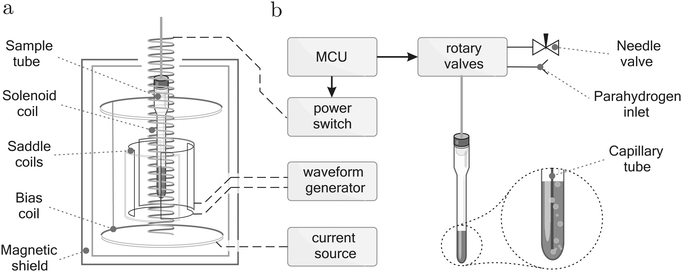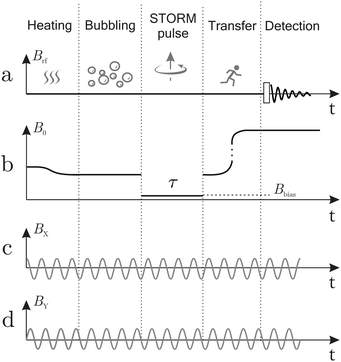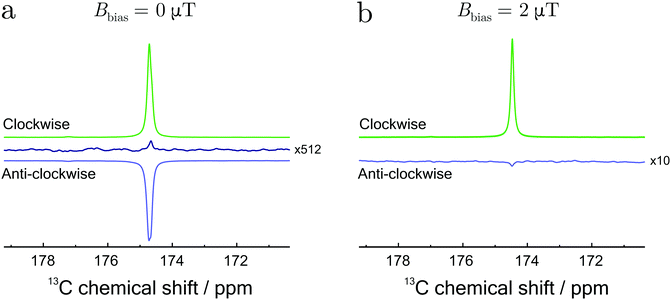 Open Access Article
Open Access ArticleCreative Commons Attribution 3.0 Unported Licence
Hyperpolarization read-out through rapidly rotating fields in the zero- and low-field regime
Laurynas
Dagys
 * and
Christian
Bengs
* and
Christian
Bengs

School of Chemistry, Highfield Campus, Southampton, SO171BJ, UK. E-mail: l.dagys@soton.ac.uk
First published on 23rd March 2022
Abstract
An integral part of para-hydrogen induced polarization (PHIP) methods is the conversion of nuclear singlet order into observable magnetization. In this study polarization transfer to a heteronucleus is achieved through a selective rotation of the proton singlet–triplet states driven by a combination of a rotating magnetic field and a weak bias field. Surprisingly we find that efficient polarization transfer driven by a STORM (Singlet–Triplet Oscillations through Rotating Magnetic fields) pulse in the presence of sub-μT bias fields requires rotation frequencies on the order of several kHz. The rotation frequencies therefore greatly exceed any of the internal frequencies of typical zero- to ultralow field experiments. We further show that the rotational direction of the rotating field is not arbitrary and greatly influences the final transfer efficiency. Some of these aspects are demonstrated experimentally by considering hyperpolarized (1-13C)fumarate. In contrast to most of the existing methods, the STORM procedure therefore represents a promising candidate for quadrupolar decoupled polarization transfer in PHIP experiments.
1 Introduction
The inherently low sensitivity of Nuclear Magnetic Resonance (NMR) may be greatly overcome through the use of hyperpolarization methods.1–21 At the core of these methods is the production of nuclear spin order far from thermal equilibrium that can lead to signal enhancements of many orders of magnitude.Particular promising techniques are para-hydrogen induced polarization (PHIP) methods.1,2,7–21 Methods of this type utilise molecular hydrogen gas enriched in its para-spin isomer, typically achieved by passing the cooled gas over an iron oxide catalyst.1,2
For the case of hydrogenative-PHIP (considered here) the para-enriched hydrogen gas (para-hydrogen) is allowed to react with a suitable precursor molecule. Upon hydrogenation the nuclear singlet order of the hydrogen gas is carried over to the product molecule. However, the resulting nuclear singlet order located on the product molecule is NMR silent. Efficient conversion of nuclear singlet order into observable magnetization is thus an integral part of the method.
A number of techniques already exist for this purpose, both at high and low magnetic fields.10–21 High field methods benefit from the usual advantages, spectral separation between hetero- and homonuclei, strong pulse schemes with error compensation and applicability to a broad class of molecular systems.11,15,21–24 However, these benefits often come at a price. Some technical challenges may arise due to additional relaxation phenomena and coherent leakage, which may lead to significant polarization losses.17,25,26
Some of these issues may be circumvented at low magnetic fields.10,13,14,17–19 This has been utilised to produce large quantities of chemically pure and hyperpolarized (1-13C)fumarate, for example.19 The reaction was carried out inside a pressurised metal reactor, which itself was placed inside a magnetic shield. The polarization transfer was performed by sweeping the magnetic field in the sub-microtesla regime. Such a setup would be impossible at high magnetic fields as the reaction vessel is incompatible with pulsed radio-frequency methods.
We have recently demonstrated that efficient polarization transfer may also be performed in the presence of a weak static magnetic field superimposed with a weak oscillating low field (WOLF) along the same direction.20 A magnetic field geometry with the oscillating field applied along the same direction as the main magnetic field is unusual for NMR, indeed if the oscillating field is applied in the conventional transverse plane the WOLF pulse becomes ineffective.
Generally speaking, the description of oscillating fields in the low magnetic field regime is complicated. In contrast to high field experiments both the resonant part and the counter-rotating part of the linearly polarised field have to be considered.27,28 However, at low magnetic fields it is technically trivial to generate rotating magnetic fields that are resonant with the nuclear spin transition frequencies. This way perturbations due to the counter-rotating components are simply avoided.
In this work we demonstrate that the application of transverse rotating fields may be exploited for the polarization transfer step in PHIP experiments. The application of a suitable STORM (Singlet–Triplet Oscillations through Rotating Magnetic fields) pulse enables polarization transfer from the singlet pair to a heteronucleus leading to substantially enhanced NMR signals. We validate some of these concepts experimentally by generating hyperpolarized (1-13C)fumarate, and explore the STORM condition as a function of the bias field, rotation frequency and sense of rotation.
We find that driving spin transitions with a rotating magnetic field in low magnetic fields requires unusually high rotation frequencies, sometimes several kHz. This is in contrast to typical zero-to-ultralow field experiments which involve frequencies on the order of several Hz at most.29–31 The observed polarization levels are comparable to other low-field techniques.17–20 In addition, we further believe that STORM pulses can be a simple solution to quadrupolar decoupled polarization transfer at low magnetic fields.32,33
2 Theory
Consider an ensemble of nuclear three-spin-1/2 systems consisting of two nuclei of isotopic type I and a third nucleus of isotopic type S. The nuclei are characterised by the magnetogyric ratio's γI and γS, respectively. For an isotropic solution, the nuclei mutually interact by scalar spin–spin coupling terms| HJ = HII + HIS, | (1) |
| HII = 2πJ12I1·I2 | (2) |
| HIS = 2πJ13I1·S+ 2πJ23I2·S. | (3) |
For the remainder of the discussion we assume the coupling constants J13 and J23 to be different (J13 ≠ J23) and a positive homonuclear coupling constant J12. The heteronuclear J coupling Hamiltonian may be split in its symmetric and anti-symmetric part
| HIS = HΣIS + HΔIS, | (4) |
 | (5) |
The nuclear spin ensemble may further be manipulated by the application of external magnetic fields. The magnetic field Hamiltonian is constructed by coupling the spin angular momenta to the external magnetic field taking their respective magnetogyric ratio's into account
| HM(t) = −γIB(t)·(I1 + I2) − γSB(t)·S. | (6) |
The total spin Hamiltonian is then given by
| H(t) =HJ + HM(t). | (7) |
2.1 Rotating field Hamiltonian
Consider now the application of a time-dependent rotating magnetic field in the presence of a weak bias field along the laboratory frame z-axis. The z-bias Hamiltonian is given by | (8) |
 | (9) |
The total spin Hamiltonian may now be expressed as a combination of scalar-coupling terms, the bias term and the rotating field contribution
| H(t) = HJ + HM(t) = HJ + Hbias + Hrot(t). | (10) |
It turns out to be advantageous to isolate the rotating part of H(t). To this end we consider an interaction frame transformation rotating all three spins equally around the laboratory frame z-axis. The angular frequency is chosen to coincide with ωrot
| Kz(t) = exp{−i(I1z + I2z + Sz)ωrott}. | (11) |
The corresponding interaction frame Hamiltonian ![[H with combining tilde]](https://www.rsc.org/images/entities/i_char_0048_0303.gif) (t) is given by
(t) is given by
 | (12) |
2.2 Effective field Hamiltonian
Within the interaction frame the spins evolve under a new effective magnetic field Beff. The coupling of the effective field to the I and S spins may be characterised by the effective nutation frequencies ωXeff | (13) |
| θXeff = arctan2(ωX0 + ωrot, ωX1). | (14) |
The polar angles describe the field direction with respect to the laboratory frame z-axis. An alternative representation of ![[H with combining tilde]](https://www.rsc.org/images/entities/i_char_0048_0303.gif) is thus given by
is thus given by
![[H with combining tilde]](https://www.rsc.org/images/entities/i_char_0048_0303.gif) = XHeffX† + HΔIS, = XHeffX† + HΔIS, | (15) |
| Heff = ωIeff(I1z + I2z) +ωSeffSz + HII + HΣIS. | (16) |
The transformation X is defined as a composite rotation of spins I and S
| X = Ry12(θIeff)Ry3(θSeff). | (17) |
Consider now the set of STZ states aligned along the effective magnetic field direction
 | (18) |
These states are exact eigenstates of the effective field part of the interaction frame Hamiltonian
| XHeffX†|Tmμ′〉 = XHeffX†X|Tmμ〉 = λX|Tmμ〉 = λ|Tmμ′〉, | (19) |
![[H with combining tilde]](https://www.rsc.org/images/entities/i_char_0048_0303.gif) and the heteronuclear coupling term HΔIS may be considered a perturbation.
and the heteronuclear coupling term HΔIS may be considered a perturbation.
2.3 Para-hydrogen induced polarization
For typical PHIP experiments involving I2S systems at sufficiently low magnetic fields we may approximate the initial state of the spin ensemble by pure singlet population | (20) |
 | (21) |
In the absence of HΔIS no heteronuclear magnetisation may be extracted out of the system, however the presence of HΔIS causes coherent mixing within the manifolds {|S0β′〉,|T0β′〉, |T−1α′〉} and {|S0α′〉,|T0α′〉, |T+1β′〉}.
Strictly speaking these two manifolds are not completely isolated from all other states. But as illustrated in Fig. 1 mixing of this type will be efficiently suppressed for our choice of the rotation frequency ωrot. Taking the first manifold for example, one may show to first order in perturbation theory that the following inequalities are well satisfied
 | (22) |
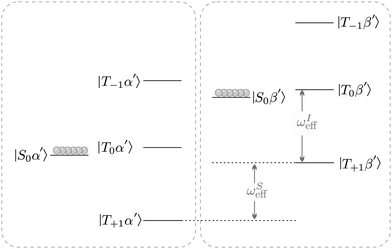 | ||
| Fig. 1 Eigenvalues and eigenstates of the effective field Hamiltonian (equation 16) in the near-equivalence limit (|J13 − J23| ≪ |J12|, with J12 referring to the homonuclear J-coupling) and J13, J23 referring to the out-of-pair couplings. The circles represent the population distribution for a fully populated singlet state between the two I-spins. The effective nutation frequency ωXeff is given by eqn (13) where X refers to either spin I or S. Primes indicate alignment of the nuclear spins states along the effective field. | ||
The energy separation between the |S0β′〉 and |T−1α′〉 state is given by
 | (23) |
As a result, coherent state mixing is maximised by choosing an optimised rotation frequency ωSTORM such that
| ΔE = 0 at ωrot = ωSTORM. | (24) |
We refer to such a scenario as the application of a STORM pulse, which causes a degeneracy between the |S0β′〉 and |T−1α′〉 state, and leads to a level anti-crossing (LAC) if the anti-symmetric heteronuclear J-couplings are included (see inset Fig. 2).34,35
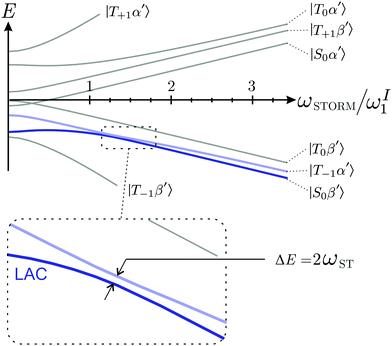 | ||
| Fig. 2 Eigenvalues and eigenstates of the interaction frame Hamiltonian (eqn (15)) as a function of the rotating magnetic field frequency ωrot at zero-field. The states |S0β′〉 and |T−1α′〉 undergo a Level-Anti Crossing (LAC) highlighted by the inset. Note that ωI1/ωS1 ≈ 4 for I = 1H and S = 13C. | ||
As shown in the appendix mixing between the |S0β′〉 and |T−1α′〉 state occurs with frequency
 | (25) |
 | (26) |
Application of a rotating magnetic field with ωrot = ωSTORM causes the states |S0β′〉 and |T−1α′〉 to approximately follow the dynamics of a two-level system (TLS).
Consider now starting from the density operator in eqn (21). The spin-state populations at time τ under the TLS approximation are given by35
 | (27) |
A complete population inversion between the |S0β′〉 and |T−1α′〉 state may be achieved by applying the STORM pulse for a duration τ* = π/ωnutST. Since the STORM pulse is only resonant with the |S0β′〉 ↔ |T−1α′〉 transition all other states experience negligible evolution. The idealised density operator after such a STORM pulse is thus given by
 | (28) |
 | (29) |
As a result, the heteronuclear spins become fully polarised as cos(θSeff) approaches unity. Representing the transfer amplitude in a slightly more intuitive form:
 | (30) |
Although much of the discussion above has focused on the {|S0β′〉,|T0β′〉,|T−1α′〉} manifold, similar results hold for the {|S0α′〉,|T0α′〉,|T+1β′〉} manifold, only difference being that the relevant energy difference has to be replaced by
 | (31) |
3 Methods
3.1 Materials
The precursor solution for fumarate was prepared by dissolving 100 mM disodium acetylene dicarboxylate, 100 mM sodium sulfite, and 6 mM [RuCp*(MeCN)3]PF6 (CAS number: 99604-67-8) in D2O, heating to 60 °C, and passing through a Millex 0.22 μm PES filter.Para-hydrogen was produced by passing hydrogen gas over an iron oxide catalyst packed in a 1/4 inch stainless steel tube cooled by liquid nitrogen which results in para-enrichment level of 50%.
About 2% of the fumarate molecules contain a naturally-occurring nucleus. The two nuclei and the nucleus form a three-spin-1/2 system of the type discussed above. The J-coupling parameters for the molecular system are consistent with ref. 15 and 20.
3.2 Equipment
A sketch of the equipment is shown in Fig. 3. The hydrogen gas is bubbled through the solution using a 1/16 inch PEEK capillary tube inserted inside a thin-walled Norell pressure NMR tube. The Arduino Mega 2560 micro-controller board was used to actuate the Rheodyne MXP injection valves as well as a power switch connected to the solenoid coil. The 50 cm long and 15 mm wide coil was designed to provide a 170 μT field piercing through the TwinLeaf MS-4 Mu-metal shield. The rotating magnetic field was generated by two 30 cm long orthogonal saddle coils using a Keysight 33500B waveform generator with two channels synchronised with phase difference of ±90°. The bias field was generated by the built-in Helmholtz coil of the Twinleaf shield, powered by a Keithley 6200 DC current source.3.3 Experimental procedure
Fig. 4 gives an overview of the experimental protocol including the magnetic field experienced by the sample as a function of time. Each experiment starts by heating 250 of the sample mixture to ∼90 in the ambient magnetic field of the laboratory (∼110 μT), followed by insertion into the magnetic shield where a solenoid coil generates a magnetic field of similar magnitude. para-Enriched hydrogen gas is bubbled through the solution at 6 bar pressure for 30 seconds. The rotating field is generated constantly by the waveform generator, the amplitude is kept constant (BSTORM = 4). The solenoid is switched off by a relay for a period τ to pre-set the bias field (Bbias) and to mimic a STORM pulse. Afterwards the sample was removed manually and inserted into the Oxford 400 MHz magnet equipped with a Bruker Avance Neo spectrometer.The free-induction decays were initiated by a hard pulse of 14.7 kHz rf amplitude and recorded with 65 k point density at a spectral width of 200 ppm. Additional decoupling was used for all experiments. Thermal equilibrium spectra were recorded at room temperature with a recycle delay of 120 s, averaging the signal over 512 transients.
4 Results
Fig. 5 shows single-transient hyperpolarized NMR spectra, obtained using the STORM procedure as a function of the rotational direction in the presence of a 0 T bias field (Fig. 5(a)) and a 2 μT bias field (Fig. 5(b)). In both cases the STORM pulse duration was set to 0.2 s with a peak amplitude of BSTORM = 4 μT. The rotation frequencies, 1150 Hz for (a) and 223 Hz for (b), correspond to the root of the eqn (23). The observed polarization levels clearly depend upon the sense of rotation. At zero field the relevant LAC conditions for positive and negative magnetization are centred symmetrically around a zero rotation frequency. A simple inversion of the rotation frequency therefore enables selection of either positive and negative magnetization. In the presence of a non-vanishing bias field the symmetry with respect to the rotation frequency is broken. This means that a single frequency can only match one condition and no signal is observed when the rotation is reversed (see Fig. 5(b)).The solid black line in Fig. 5(a) represents a reference spectrum averaged over 512 transients. The spectrum was obtained on the hydrogenated sample after thermal equilibration. Comparison of these spectra allows an estimation of the polarization levels, which in this case corresponds to pSz ≃ 6%. These results are comparable with previous methods under similar experimental conditions.14,17,18,20 Significant improvements in the polarization are expected by addressing few aspects of the setup. Fully enriched para-hydrogen would lead to 3-fold enhancement, whereas careful optimization of the reaction conditions would further lead to a better polarization yield.14,18 Some minimal losses could be also avoided by using a fully automated experimental procedure.
Integrated signal amplitudes as a function of the rotation frequency and the STORM pulse duration τ at bias field of 0 T and 2 μT are shown in Fig. 6 and 7. Each experimental point was obtained from a separate experiment on a fresh sample. The experimental data has been normalised to unity to enable a qualitative comparison with numerical simulations and analytically derived curves based on eqn (27). The agreement between both curves and the experimental data is gratifying.
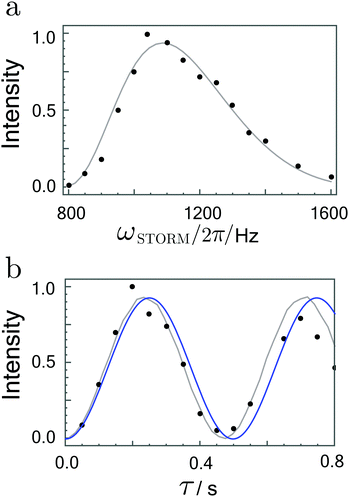 | ||
| Fig. 6 (a) Hyperpolarized fumarate intensities as a function of STORM pulse frequency ωSTORM with a fixed pulse duration of 200 ms. (b) Hyperpolarized fumarate intensities as a function of pulse duration τ with a fixed STORM frequency of 1100 Hz. The bias field and rotating field are fixed at 0 μT and 4 μT, respectively. Grey lines represent numerical SpinDynamica36 simulations, whereas blue lines plot the analytical solution given by eqn (27). The intensity scales are normalised to the maximum signal obtained. | ||
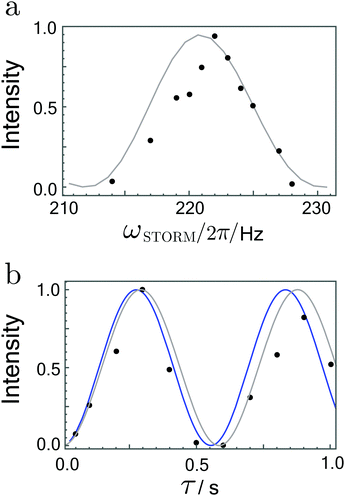 | ||
| Fig. 7 (a) Hyperpolarized fumarate intensities as a function of STORM pulse frequency ωSTORM with a fixed pulse duration of 400 ms. (b) Hyperpolarized fumarate intensities as a function of pulse duration τ with a fixed STORM frequency of 222 Hz. The bias field and rotating field are fixed at 2 μT and 4 μT, respectively. Grey lines represent numerical SpinDynamica36 simulations, whereas blue lines plot the analytical solution given by eqn (27). The intensity scales are normalised to the maximum signal obtained. | ||
The frequency profiles obtained at different bias fields display a significant change in their width. At zero-field the full width at half maximum of the profile was estimated to be ∼350 Hz whereas at 2 μT bias field width got reduced to ∼5 Hz. These matching conditions are much broader than the 0.4 Hz width observed in the profiles using the WOLF method.20 In agreement with the analytic expression given by eqn (25), the polarization transfer rate did not vary dramatically with an increase in the bias field. For both cases, eqn (25) correctly predicts the polarisation transfer rate to be approximately ∼2 Hz, where we have used the J-coupling parameters of fumarate given in ref. 15 and 20.
5 Conclusions
In this work we have studied the polarization transfer from singlet order to heteronuclear magnetization in the context of para-hydrogen induced polarization. The polarization transfer is achieved through a combination of a rotating magnetic field and a small bias field. Despite low values of the static bias field, the rotation frequency needed to drive the transfer is strikingly large. However, the principle of the method described here is rather intuitive and a simple explanation may be given within the framework of level-anti crossings, at least when the Hamiltonian is expressed within the interaction frame of the rotating magnetic field. Based on the LAC picture we were able to establish the resonance conditions for singlet–triplet mixing and determine the corresponding population transfer rate. In particular, we have shown that the rotational direction plays an important role in correctly establishing the resonance condition, and should be chosen carefully in the experimental context.There are other methods to convert nuclear singlet order into heteronuclear polarization, including resonant pulse schemes in high field as well as magnetic field-cycling at low magnetic fields.10–21 The STORM method introduced here is conceptually simple and provides a few advantages over other existing low field methods. The potential polarization losses caused by additional relaxation effects in high magnetic fields are entirely avoided with use of low magnetic fields.17,25,26 However, at ultra-low fields quadrupolar nuclei such as 2H or 14N often act as polarization sinks, and may lead to a significant drops in the polarization transfer efficiency. The presence of quadrupolar nuclei is expected to be particularly disrupting to adiabatic field sweep methods, some of which are routinely utilised in the generation of hyperpolarized (1-13C)fumarate.17–19 In contrast to field sweep methods, the STORM method allows one to freely select the strength of magnetic fields as well as the rotation frequency. It is thus conceivable that optimal conditions for the magnetic field strength and rotation frequency exist at which the 2H or 14N spins do not interfere with the polarization transfer process. We therefore believe that STORM pulses represent promising candidates for a new class of quadrupolar decoupled polarization transfer methods in the near future. Applications to other hyperpolarization techniques such as PHIP-SABRE (Signal Amplification by Reversible Exchange) are also conceivable.9,11,12,25
Conflicts of interest
There are no conflicts to declare.Appendix
STORM nutation frequency
Consider the manifold defined by | (32) |
![[H with combining tilde]](https://www.rsc.org/images/entities/i_char_0048_0303.gif) restricted to V1 manifold is of the following form
restricted to V1 manifold is of the following form | (33) |
The energy separation between the |S0β′〉 and |T0β′〉 state equals |2πJ12| and is not quite sufficient to perform a TLS approximation. We thus diagonalise the corresponding subspace making use of the mixing angle
 | (34) |
After the diagonalisation process the matrix representation of ![[H with combining tilde]](https://www.rsc.org/images/entities/i_char_0048_0303.gif) takes the form
takes the form
 | (35) |
Acknowledgements
We acknowledge funding received by the Marie Skłodowska-Curie program of the European Union (grant number 766402), the European Research Council (grant 786707-FunMagResBeacons), and EPSRC-UK (grants EP/P009980/1, EP/P030491/1, EP/V055593/1). We thank Malcolm H. Levitt for valuable input and support during preparation of the manuscript.References
- J. Natterer and J. Bargon, Prog. Nucl. Magn. Reson. Spectrosc., 1997, 31, 293–315 CrossRef.
- C. R. Bowers and D. P. Weitekamp, J. Am. Chem. Soc., 1987, 109, 5541–5542 CrossRef CAS.
- J. H. Ardenkjaer-Larsen, B. Fridlund, A. Gram, G. Hansson, L. Hansson, M. H. Lerche, R. Servin, M. Thaning and K. Golman, Proc. Natl. Acad. Sci. U. S. A., 2003, 100, 10158–10163 CrossRef CAS PubMed.
- T. Maly, G. T. Debelouchina, V. S. Bajaj, K.-N. Hu, C.-G. Joo, M. L. Mak–Jurkauskas, J. R. Sirigiri, P. C. A. van der Wel, J. Herzfeld, R. J. Temkin and R. G. Griffin, J. Chem. Phys., 2008, 128, 052211 CrossRef PubMed.
- T. G. Walker and W. Happer, Rev. Mod. Phys., 1997, 69, 629–642 CrossRef CAS.
- K. V. Kovtunov, E. V. Pokochueva, O. G. Salnikov, S. F. Cousin, D. Kurzbach, B. Vuichoud, S. Jannin, E. Y. Chekmenev, B. M. Goodson, D. A. Barskiy and I. V. Koptyug, Chem. – Asian J., 2018, 13, 1857–1871 CrossRef CAS PubMed.
- M. Emondts, J. F. P. Colell, B. Blümich and P. P. M. Schleker, Phys. Chem. Chem. Phys., 2017, 19, 21933–21937 RSC.
- M. Stephan, O. Kohlmann, H. G. Niessen, A. Eichhorn and J. Bargon, Magn. Reson. Chem., 2002, 40, 157–160 CrossRef CAS.
- R. W. Adams, J. A. Aguilar, K. D. Atkinson, M. J. Cowley, P. I. P. Elliott, S. B. Duckett, G. G. R. Green, I. G. Khazal, J. López-Serrano and D. C. Williamson, Science, 2009, 323, 1708–1711 CrossRef CAS PubMed.
- H. Jóhannesson, O. Axelsson and M. Karlsson, C. R. Phys., 2004, 5, 315–324 CrossRef.
- T. Theis, M. Truong, A. M. Coffey, E. Y. Chekmenev and W. S. Warren, J. Magn. Reson., 2014, 248, 23–26 CrossRef CAS PubMed.
- T. Theis, M. L. Truong, A. M. Coffey, R. V. Shchepin, K. W. Waddell, F. Shi, B. M. Goodson, W. S. Warren and E. Y. Chekmenev, J. Am. Chem. Soc., 2015, 137, 1404–1407 CrossRef CAS PubMed.
- E. Cavallari, C. Carrera, T. Boi, S. Aime and F. Reineri, J. Phys. Chem. B, 2015, 119, 10035–10041 CrossRef CAS PubMed.
- J. Eills, J. W. Blanchard, T. Wu, C. Bengs, J. Hollenbach, D. Budker and M. H. Levitt, J. Chem. Phys., 2019, 150, 174202 CrossRef PubMed.
- C. Bengs, L. Dagys and M. H. Levitt, J. Magn. Reson., 2020, 321, 106850 CrossRef CAS PubMed.
- S. J. DeVience, M. Greer, S. Mandal and M. S. Rosen, ChemPhysChem, 2021, 22, 2128–2137 CrossRef CAS PubMed.
- B. A. Rodin, V. P. Kozinenko, A. S. Kiryutin, A. V. Yurkovskaya, J. Eills and K. L. Ivanov, J. Magn. Reson., 2021, 327, 106978 CrossRef CAS PubMed.
- B. A. Rodin, J. Eills, R. Picazo-Frutos, K. F. Sheberstov, D. Budker and K. L. Ivanov, Phys. Chem. Chem. Phys., 2021, 23, 7125–7134 RSC.
- S. Knecht, J. W. Blanchard, D. Barskiy, E. Cavallari, L. Dagys, E. V. Dyke, M. Tsukanov, B. Bliemel, K. Münnemann, S. Aime, F. Reineri, M. H. Levitt, G. Buntkowsky, A. Pines, P. Blümler, D. Budker and J. Eills, Proc. Natl. Acad. Sci. U. S. A., 2021, 118, e2025383118 CrossRef CAS PubMed.
- L. Dagys, C. Bengs and M. H. Levitt, J. Chem. Phys., 2021, 15, 154201 CrossRef PubMed.
- L. Dagys, A. P. Jagtap, S. Korchak, S. Mamone, P. Saul, M. H. Levitt and S. Glöggler, Analyst, 2021, 146, 1772–1778 RSC.
- S. J. DeVience, R. L. Walsworth and M. S. Rosen, Phys. Rev. Lett., 2013, 111, 173002 CrossRef PubMed.
- A. N. Pravdivtsev, A. V. Yurkovskaya, N. N. Lukzen, K. L. Ivanov and H.-M. Vieth, J. Phys. Chem. Lett., 2014, 5, 3421–3426 CrossRef CAS PubMed.
- M. Haake, J. Natterer and J. Bargon, J. Am. Chem. Soc., 1996, 118, 8688–8691 CrossRef CAS.
- S. Knecht, A. S. Kiryutin, A. V. Yurkovskaya and K. L. Ivanov, J. Magn. Reson., 2018, 287, 74–81 CrossRef CAS PubMed.
- S. Knecht, S. Hadjiali, D. A. Barskiy, A. Pines, G. Sauer, A. S. Kiryutin, K. L. Ivanov, A. V. Yurkovskaya and G. Buntkowsky, J. Phys. Chem. C, 2019, 123, 16288–16293 CrossRef CAS.
- C. A. Meriles, D. Sakellariou, A. Moulé, M. Goldman, T. F. Budinger and A. Pines, J. Magn. Reson., 2004, 169, 13–18 CrossRef CAS PubMed.
- D. Sakellariou, C. A. Meriles, R. W. Martin and A. Pines, Magn. Reson. Imaging, 2005, 23, 295–299 CrossRef CAS PubMed.
- G. Pileio, M. Carravetta and M. H. Levitt, Phys. Rev. Lett., 2009, 103, 083002 CrossRef PubMed.
- T. F. Sjolander, M. C. D. Tayler, A. Kentner, D. Budker and A. Pines, J. Phys. Chem. Lett., 2017, 8, 1512–1516 CrossRef CAS PubMed.
- T. F. Sjolander, M. C. D. Tayler, J. P. King, D. Budker and A. Pines, J. Phys. Chem. A, 2016, 120, 4343–4348 CrossRef CAS PubMed.
- J. R. Birchall, M. S. H. Kabir, O. G. Salnikov, N. V. Chukanov, A. Svyatova, K. V. Kovtunov, I. V. Koptyug, J. G. Gelovani, B. M. Goodson, W. Pham and E. Y. Chekmenev, Chem. Commun., 2020, 56, 9098–9101 RSC.
- M. C. D. Tayler and L. F. Gladden, J. Magn. Reson., 2019, 298, 101–106 CrossRef CAS PubMed.
- B. A. Rodin and K. L. Ivanov, Magn. Reson., 2020, 1, 347–365 CrossRef.
- A. Messiah, Quantum Mechanics, North-Holland, 1962 Search PubMed.
- C. Bengs and M. H. Levitt, Magn. Reson. Chem., 2018, 56, 374–414 CrossRef CAS PubMed.
| This journal is © the Owner Societies 2022 |

